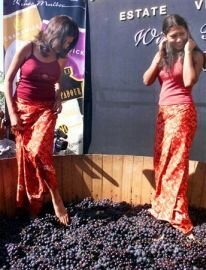Fri 18 Nov 2005

Photo: Indian girls crush grapes during the Chateau Indage Wine Festival 2003 in Narayangaon 228 km north of Bombay, February 8, 2003. Best known for its teas and spices, India now aims to place its wines on supermarket shelves in Europe and the United States. REUTERS/Roy Madhur
India’s wine market is estimated at 5 million bottles a year — equivalent to around 200 people sharing one bottle — and, at 2.75 billion rupees, makes up less than 1 percent of India’s $1.8 billion alcoholic drinks market.
But the wine market is growing at 25-30 percent a year, nearly three times as fast as beer, whisky or rum, which together make up 45 percent of the total. Exports currently make up about 10-15 percent of total output.
“Consumer attitudes towards wine have really changed,” said Rajeev Samant, who runs Sula Vineyards in Nashik, 120 miles (190 km) north of Mumbai, formerly Bombay.
“It’s seen as more sophisticated and healthier than liquor, and therefore more acceptable for women or youngsters who are starting to drink.”
Youth appeal is important in a country where more than half the 1 billion-plus population is below the age of 25.
For related factbox, double click on
NEW WORLD NOVELTY
After a 15-year struggle to turn Indian consumers on to the grape, Kapil Grover feels vindicated by a recent issue of ‘Decanter’ magazine, which named his ‘La Reserve’ as the best red among New World wines.
“It has put Indian wine on the world map,” said Grover, whose father first planted imported French grape varieties in 1988 on 20 acres (8 ha) at the foot of the Nandi Hills north of Bangalore.
Funded by other family businesses for years, Grover Vineyards has expanded 10-fold and now sells a range of Cabernet Sauvignon, Shiraz, Clairette and Sauvignon Blanc wines.
While small farmers scramble to plant grapes, wealthy entrepreneurs, private equity firms and foreign labels are all sizing up India’s wine market.
Seagram plans to set up a winery in Nashik, and Australia’s Foster’s Group Ltd. will soon launch its wine brands.
“We’re seeing a bullishness from investors and we require funds to expand capacity and (make) acquisitions as the market grows,” said Ranjit Chougule, managing director of Champagne Indage, the local market leader.
Grover is to plant grapes on 50 acres of land owned by Jerry Rao, head of software services firm MphasiS BFL.
“Just as happened in Napa Valley, we’re seeing a lot of interest from Bangalore’s tech people,” Grover said, recalling the California wine rush triggered by the 1990s dotcom boom.
India’s wine market is still a tiny fraction of China’s $7 billion industry that has attracted millions of dollars from private equity firms and foreign labels.
But even the Chinese drink on average less than two glasses of wine a year, compared with 59 litres a head in France and 12 litres in the United States.
LONG HISTORY
Wine-making in India dates back several hundred years.
Mughal kings were as devoted to fine wines as to grand architecture, and the British made wine fashionable. Before foreign brands arrived in 2002, local fruit wines were popular.
The recent take-off in demand was helped by regulatory changes triggered when the western state of Maharashtra declared wine-making a food processing industry in 2001, exempting it from excise duty and slashing sales taxes.
At least 20 wineries have sprung up around Nashik and Pune, known for their cooler, yet sunny climate — a far cry from the 1980s when Grover spent years seeking a suitable location for his grapes, before settling on the southern Karnataka state.
“It’s a very profitable business now, but when we began exports (in 1999), Indian restaurants in London were very resistant, unlike their acceptance of beers like Kingfisher,” said Grover, referring to the top brand from local United Breweries.
International wine experts reckon it’s time consumers tried wine with curry, preferably fruity, assertive wines that complement spicy Asian dishes.
United now has two wine brands in India and is looking to tie up with a local or foreign brand to raise its profile.
“You can’t do a Chardonnay, Merlot or Pinot Noir in India and you live with that, but we’re looking at a more distinctly Indian label to make our wines stand out from other New World wines,” Grover said.
Sula, which sold its first bottle of wine in 2000, has more than 300 acres of grapes under cultivation and will sell more than 1 million bottles this year, including a sparkling wine, a Chenin Blanc, a Cabernet Shiraz, a Sauvignon Blanc and a blush Zinfadel. A planned third winery will take capacity to 1.75 million litres a year.
LOCALS GETTING A TASTE
Wine makers now host wine tours and harvest festivals in India, and Sula has a 2,000 sq ft (186 sq m) tasting room overlooking its vineyards, nestled amid scenic lakes and hills.
“India is in the news a lot these days and is perceived as cool and hip, and Indian food is also becoming popular,” said Sula’s Samant, a Stanford engineering graduate who quit his job at Oracle Corp. to head his family’s farm.
But consumption in India remains low and there is strong opposition to easing regulations in a country where drinking tends to be frowned upon and wine is seen as a luxury product.
High taxes and rules against selling wine in department and grocery stores in most Indian cities push up the cost of a bottle of wine, said Sonal Shah, who heads the strategic advisory division at Rabo India.
Shah reckons three-quarters of local wine sold in India sells for 200-600 rupees a bottle — more than the price of a local wine in London or Paris.
But it is not just the rich city dwellers that wine makers are targeting: enterprising farmers are naming their wines after their villages, locals visit Sula’s tasting room, and Indage has launched a brand at less than 100 rupees a bottle.
“The only way to grow the market is by making wine a utility, making it affordable and accessible,” said Chougule, whose firm began making sparkling wine nearly 20 years ago and will export a quarter of this harvest’s output under its Chateau Indage label.







